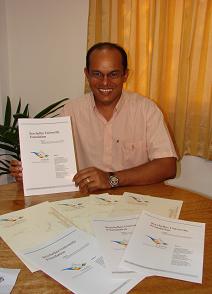From: IPPMedia
Nov 2007
By Guardian Correspondent
The consortium for Conservation of Coastal and Marine Ecosystems in Western Indian Ocean`, (WIO-C), was launched yesterday at the on going conference of parties to the Nairobi and Abidjan Convention in Johannesburg.
The consortium seeks to influence the development of policies that balance conservation and development needs through high profile and high-level engagement.
The consortium whose main focus is on sharing of information, lessons and best practices; monitoring for improved management and capacity building on the future of coastal and marine livelihood was launched by Dr. Rolph Payet, the Interim Regional Coordinator of the Nairobi Convention.
It is a joint initiative by the World Conservation Union (IUCN), the World Wide Fund for Nature (WWF), the Western Indian Ocean Marine Science Association (WIOMSA), the Coral Reef Degradation in the Indian Ocean (CORDIO), the Wildlife Conservation Society (WCS) and United Nations Environment Program (UNEP)
Others are Indian Ocean Commission (IOC), the New Partnership for Africa’s Development Coastal and Marine sub-programme; (NEPAD/ COSMAR), Intergovernmental Oceanographic Commission of the United Nations Educational, Scientific and Cultural Organization (IOC/UNESCO), aimed at developing synergistic partnerships that will advance marine research, conservation and management in the Western Indian Ocean region.
Over the years, the governments of the Western Indian Ocean have voiced concern over the continued degradation of the marine and coastal environment; consequently, several regional organisations have developed coastal and marine conservation programmes in the Eastern and Southern Africa including the Island States of the West Indian Ocean (WIO).
These programmes include the WWF coordinated Eastern African Marine Ecoregion (EAME), IUCN’s Eastern Africa Marine and Coastal Ecosystems Programme and other projects implemented by CORDIO, WIOMSA, WCS, UNEP and UNESCO.
Due to the multiplicity of projects and programmes, a number of key stakeholders have come together to discuss and agree on how the initiatives can be more effective in influencing decision making and changing the face of natural resource management in Western Indian Ocean. WIO-C has been formed to rationalise these efforts.
`It is recognised that such collaboration will not only advance the sustainable use and conservation of coastal and marine ecosystems and associated resources, but that it will also contribute to sustainable livelihood and poverty reduction in the region,` said Dr. Payet .
The mission of WIO-C is to become the principle mechanism for reaching a broad stakeholder engagement in the formulation and implementation of the programme of Work for the Nairobi Convention.
The nine founding members are therefore committed to anchor the Consortium in the Nairobi Convention for the Protection, Management and Development of the marine and coastal environment of the Eastern and Southern Africa (Western Indian Ocean) Region.
The consortium consists of a highly credible network of organizations that will be able to provide decision support, share information and management experiences, mobilize resources and develop collaborative programmes.
In particular these activities will relate to the regional and transboundary issues.
The main purpose of the consortium is to support synergy and strengthen coordination in the implementation of activities and programmes related to marine and coastal ecosystem management, research and development.
The consortium will also be instrumental in promoting knowledge and information sharing amongst stakeholders in the Western Indian Ocean region with a view to anchoring activities within the framework of the Nairobi Convention, says the statement.
While the nine-member leadership group will steer the consortium, the day-to-day secretariat functions will be a revolving responsibility – initially undertaken by the WWF-Eastern African Marine Ecoregion Team based in Dar Es Salaam, Tanzania, it says.
The consortium was established at the Meeting of the Partners that was held in Nairobi, Kenya from August 31 to September 1, 2006.
* SOURCE: Guardian



 about the university’s plans, saying it has already acquired two plots of land, one at Mont Fleuri and the other at Anse Royale.
about the university’s plans, saying it has already acquired two plots of land, one at Mont Fleuri and the other at Anse Royale.